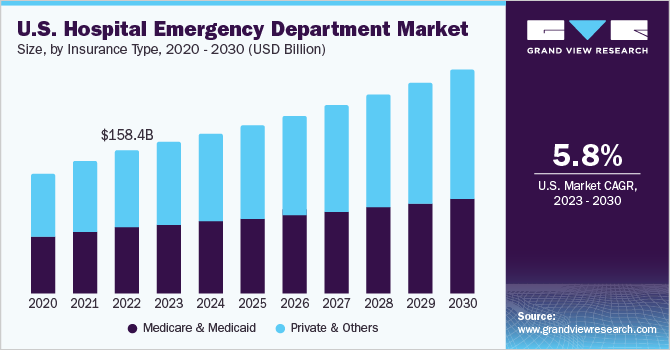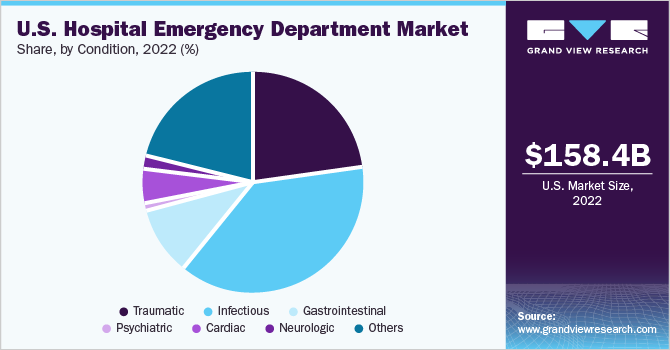- Home
- »
- Medical Devices
- »
-
U.S. Hospital Emergency Department Market Report, 2030GVR Report cover
![U.S. Hospital Emergency Department Market Size, Share & Trends Report]()
U.S. Hospital Emergency Department Market Size, Share & Trends Analysis Report By Insurance Type (Medicare & Medicaid, Private), By Condition (Gastrointestinal, Cardiac, Infectious, Traumatic), And Segment Forecasts, 2023 - 2030
- Report ID: GVR-4-68039-264-2
- Number of Report Pages: 100
- Format: PDF, Horizon Databook
- Historical Range: 2018 - 2021
- Forecast Period: 2023 - 2030
- Industry: Healthcare
Report Overview
The U.S. hospital emergency department market size was estimated at USD 158.4 billion in 2022 and is expected to grow at a compound annual growth rate (CAGR) of 5.75% from 2023 to 2030. The major factor driving the growth of this market includes a high number of visits to hospital Emergency Departments (EDs) and the availability of insurance. According to the CDC, in 2020, there were approximately 131 million ED visits in the U.S. annually. Approximately 19% of adults and 4.7% of children visited EDs in 2020. Around 60% of the emergency care was provided during non-business hours, making the non-availability of less expensive options an important factor contributing to the high number of ED visits.

Hospital EDs provide treatment for various indications, such as cardiology, neurology, gastroenterology, infectious diseases, and psychiatry. Increasing the incidence of these conditions is rising the number of ED visits. Furthermore, the growing geriatric population in the U.S. is favoring the market growth, as the elderly often require urgent medical interventions. Many hospitals are adopting advanced technologies and tools, such as Artificial Intelligence (AI), to provide improved diagnosis and expedite routine procedures, such as devising patient treatment plans and prescriptions. The COVID-19 pandemic increased the adoption of telehealth in hospitals to multiple folds.
The use of telehealth is helping the hospital to reduce waiting time and overcrowding in the EDs. Medicare and Medicaid offer insurance for emergency health services. According to the CDC, over 40% of ED visits by adults over 65 are by ambulance, covered under Medicare Part B. Part B Medicare also covers air ambulance trips by helicopter or airplane if care is necessary. Medicare Part A covers a portion of the cost if the patient enters the emergency room and is admitted as an inpatient, while Medicare Part B covers the portion of the cost if the patient receives care from a doctor but is not admitted as an inpatient.
COVID-19 U.S. Hospital Emergency Department Market Impact: 10.7% increase from 2020 to 2021
Pandemic Impact
Post COVID Outlook
A decline in the number of patients attending hospital EDs in the U.S. was observed in the initial few months of the pandemic. According to CDC pre-pandemic 2019 data, 12% of ED visits were for children which declined to 6% during the COVID-19 pandemic.
In response to the pandemic, many hospitals started and will continue to offer virtual consultations to patients. This is expected to have a positive impact on market growth in the coming year. For instance, The New York-Presbyterian/Weill Cornell Medical Center (NYPWC) started using telemedicine in its ED to reduce wait times.
The decline in ED visits was largely due to social distancing norms and restrictions on movement, which resulted in millions of dollars in revenue loss. Visits decreased from a mean of 2.1 million per week (Mar 31 to Apr 27, 2019) to 1.2 million per week (Mar 29 to Apr 25, 2020), according to National Syndromic Surveillance Programs.
Signs of recovery in emergency rooms are aided by a recent return of activity, with hospitals witnessing an increase in the number of surgeries. As the number of surgical procedures is growing, healthcare organizations are adopting a flexible and cost-effective model to meet turnaround in demand.
Favorable reimbursement for ED services is contributing to the growth of the market for U.S. hospital emergency departments. Various measures to expand EDs to accommodate more patients are expected to help address the problem of ED overcrowding. For instance, in September 2022, CHA Hollywood Presbyterian Medical Center, located in Los Angeles, inaugurated a rapid-access emergency department to accelerate the provision of medical care. This system is strategically designed to fast-track the treatment of patients requiring less intensive care, thereby creating room for individuals needing more comprehensive attention.
Insurance Type Insights
Based on the insurance type, the market is further bifurcated into Medicare & Medicaid and private & others. The private & others segment dominated the market with a revenue share of 46.4% in 2022 and is expected to witness the fastest growth rate over the forecast period. This is owing to the increasing number of commercial insurance providers and rising disposable income levels. For instance, a study conducted by a researcher at the University of North Carolina found that from 1996 to 2015, private insurance providers paid more for ED visits than Medicare or Medicaid. Some private payers use value-based care strategies to reduce ED visits and hospitalizations rather than cutting coverage. Humana, for example, used value-based care models in Medicare Advantage plans, which resulted in fewer ED visits.
Preventive screenings, collaboration with care teams, and effective management of chronic illnesses are all components of a value-based care model that can help reduce the number of emergency room visits. This is expected to boost the growth of the private player’s segment. The Medicare and Medicaid segment held a significant share of the market for U.S. hospital emergency departments. This can be attributed to the high number of beneficiaries covered under Medicare. According to CMS, it is estimated that around 61.5 million Americans are enrolled in Medicare in 2021. Out of these, 3.8 million were new enrollees. These total beneficiaries include 49% of people between the ages 65 and 74, followed by 26% between 84, 14% under age 65, and 11% are 85 or older.
Condition Insights
Based on the condition, the market is segmented into traumatic, infectious, gastrointestinal, psychiatric, cardiac, neurologic, and others. The infectious conditions segment dominated the market with the largest revenue share of 37.5% in 2022. This can be attributed to increasing ER visits during flu season. According to the CDC National Hospital Ambulatory Medical Care Survey, in 2018, fever and cough accounted for 5,837,000 and 4,955,000 emergency visits in the U.S. The segment is projected to witness the highest CAGR of 6.18% during the forecast period owing to the high transmissibility of infectious diseases.

Significant increases in the number of motor vehicle accidents and increasing incidence of spinal cord injury, TBI, unintentional falls, and concussion are expected to drive the growth of the traumatic conditions segment. Traumatic Brain Injury (TBI) is a major cause of disability and death in the U.S. As per the National Hospital Ambulatory Medical Care Survey, there were 0.3 million ED visits due to accidents and 35 million ED visits due to injury in the U.S. This is likely to favor segment growth.
On the other hand, gastrointestinal and cardiac conditions segments are expected to grow at a moderate rate in the market for U.S. hospital emergency departments during the forecast period. According to the Nationwide Emergency Department Sample, in 2018, a total of 7.07 million and 3.6 million ED visits took place due to diseases of the digestive and circulatory systems, respectively. The U.S.'s rising burden of digestive and cardiac diseases will likely favor both segments' growth.
Key Companies & Market Share Insights
The market for hospital emergency departments in the U.S. is characterized by the increasing focus of hospitals on adopting technologically advanced tools for facilitating improved ED services to patients. Expansion of the existing EDs and partnering with providers of emergency service management are key strategies hospitals adopt to tackle the problem of ED overcrowding. The U.S. emergency department market is highly competitive as hospitals compete to provide better service and improved patient experience. Service providers aim to obtain accreditations and certifications to increase their credibility among patients.
For instance, in January 2023, Owensboro Health Regional Hospital (OHRH) introduced a novel communication tool within its Emergency Department. This innovative mobile platform aims to enhance patient experiences by providing them with real-time updates throughout their visit. In August 2022, Virginia Mason Franciscan Health (VMFH) announced the construction of Washington state's hybrid ER/urgent care center. This initiative signifies the commencement of VMFH's plan to create a sequence of hybrid establishments in the Puget Sound region over the upcoming four years. These facilities will adopt Intuitive Health's innovative care methodology, effortlessly integrating emergent and urgent care services under one roof. Some prominent players in the U.S. hospital emergency department market include:
-
Parkland Health
-
Lakeland Regional Health
-
St. Joseph’s Health
-
Natchitoches Regional Medical Center
-
Schoolcraft Memorial Hospital
-
Clarion Hospital
-
USA Health
-
Baptist Health South Florida
-
Montefiore Medical Center
-
LAC+USC Medical Center
U.S. Hospital Emergency Department Market Report Scope
Report Attribute
Details
Revenue forecast in 2030
USD 246.3 billion
Growth rate
CAGR of 5.75% from 2023 to 2030
Base year for estimation
2022
Historical data
2018 - 2021
Forecast period
2023 - 2030
Report updated
September 2023
Quantitative units
Revenue in USD million/billion, and CAGR from 2023 to 2030
Report coverage
Revenue forecast, company ranking, competitive landscape, growth factors, and trends
Segments covered
Insurance type, condition
Country scope
U.S.
Key companies profiled
Parkland Health; Lakeland Regional Health; St. Joseph’s Health; Natchitoches Regional Medical Center; Schoolcraft Memorial Hospital; Clarion Hospital; USA Health; Baptist Health South Florida; Montefiore Medical Center; LAC+USC Medical Center
Customization scope
Free report customization (equivalent up to 8 analysts working days) with purchase. Addition or alteration to country, regional & segment scope.
Pricing and purchase options
Avail customized purchase options to meet your exact research needs. Explore purchase options
U.S. Hospital Emergency Department Market Report Segmentation
This report forecasts revenue growth at country level and provides an analysis of the latest trends in each of the sub-segments from 2018 to 2030. For this study, Grand View Research has segmented the U.S. hospital emergency department market report on the basis of insurance type, and condition:
-
Insurance Type Outlook (Revenue, USD Million, 2018 - 2030)
-
Medicare & Medicaid
-
Private & Others
-
-
Condition Outlook (Revenue, USD Million, 2018 - 2030)
-
Traumatic
-
Infectious
-
Gastrointestinal
-
Psychiatric
-
Cardiac
-
Neurologic
-
Others
-
Frequently Asked Questions About This Report
b. The U.S. hospital emergency department market size was estimated at USD 158.4 billion in 2022 and is expected to reach USD 166.5 billion in 2023.
b. The U.S. hospital emergency department market is expected to grow at a compound annual growth rate of 5.75% from 2023 to 2030 to reach USD 246.3 billion by 2030.
b. The infectious segment dominated the U.S. hospital emergency department market with a share of 37.5% in 2022. This is attributable to the rising prevalence of infectious diseases and increasing ED utilization.
b. Some key players operating in the U.S. hospital emergency department market include Parkland Health & Hospital System, Lakeland Regional Health, St. Joseph's Health, Natchitoches Regional Medical Center, Schoolcraft Memorial Hospital, USA Health, Baptist Health South Florida, Montefiore Medical Center, and Clarion Hospital.
b. Key factors that are driving the U.S. hospital emergency department market growth include an increase in the number of hospital ED visits and the availability of insurance. Furthermore, the growing geriatric population in the U.S. is contributing to the increasing ED visits, as the elderly often require emergency care.
Share this report with your colleague or friend.
![gvr icn]()
NEED A CUSTOM REPORT?
We can customize every report - free of charge - including purchasing stand-alone sections or country-level reports, as well as offer affordable discounts for start-ups & universities. Contact us now
![Certified Icon]()
We are GDPR and CCPA compliant! Your transaction & personal information is safe and secure. For more details, please read our privacy policy.
We are committed towards customer satisfaction, and quality service.
"The quality of research they have done for us has been excellent."





